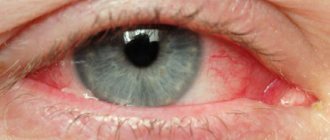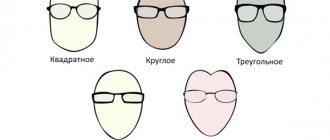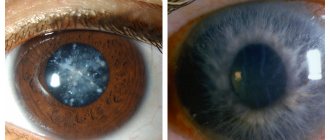What to do if dark circles appear before your eyes
Ophthalmologists advise making several rotational movements with your eyes, and then looking up and down several times. If there are foreign particles floating in the vitreous body of the eye, this will help get rid of them. Such exercises will relieve spasm of the eye muscle caused by strain on the eyes (for example, working at a computer).
If dark circles before your eyes appear when you stand up suddenly, then you just need to freeze for a few seconds - the pressure will return to normal and your vision will normalize. If dark circles begin to dance during exercise or walking, then the cause may be low blood glucose levels. Take a break and eat something sweet.
Dark circles before the eyes are one of the symptoms of high blood pressure, so it’s a good idea to measure it. With a sharp change in lighting, when looking at objects that are too bright, or with a sudden change in body position, even a completely healthy person can see circles before the eyes.
DISCUSS THIS ON THE FORUM
Rainbow circles before the eyes: the cause
Rainbow circles in the eyes are an unpleasant phenomenon that causes anxiety, discomfort and psychological stress in a person. The nature of the appearance of multi-colored halos is associated with the so-called diffraction phenomenon. It can be observed if you look at a street lamp at night through a veil of rain or a foggy car window. A similar effect also appears if you look at a light source through scratched glasses.
The appearance of iridescent halos before the eyes is based on a change in the refractive power of the cornea, which contributes to a change in the angle of focusing of light rays on the retina.
As a rule, with a long-term systematic manifestation, this pathology indicates serious disorders in the human body. In most cases, the problem is associated with ophthalmological diseases. It may also be a symptom of a neurological or psychiatric disorder. The first thing you should do is contact an ophthalmologist and undergo a comprehensive examination of your vision organs. If necessary, the doctor will redirect the patient to other specialized specialists.
Rainbow circles before the eyes can be caused by:
- Ophthalmological diseases;
- Neurological disorders;
- Psychiatric disorders.
Causes of changes in the vitreous body:
- aging: after 50 years this is a normal phenomenon;
- myopia: nearsighted people are especially prone to such changes; in their case, dark circles may appear even in adolescence;
- eye injuries: if blood particles enter the vitreous body, they will create a shadow on the retina;
- inflammatory processes;
- metabolic disease;
- high blood pressure;
- other factors.
If the cause of visual impairment is not destruction of the vitreous body, then vision problems may go away on their own, but a visit to an ophthalmologist will not be superfluous.
Treatment of blackheads appearing before the eyes
It is worth noting that this pathology cannot be treated with folk remedies, much less disappears on its own. Various methods based on the use of medicinal plants can be useful as additional methods in eliminating the cause that provoked the destruction. However, they are not used as primary therapy.
So, if you suspect the presence of a pathology, you must contact an ophthalmologist who will conduct a diagnosis and confirm or refute the patient’s suspicions.
If a disease is detected, its degree is determined. The doctor must also determine why the disorder occurred and eliminate the root cause. This may require consultation with other highly specialized specialists.
If there are minor changes, that is, at the initial stages of destruction, the main measures are aimed at identifying and eliminating the cause that led to visual impairment. For example, these could be preventive measures aimed at improving metabolism and overall strengthening of the body, involving the intake of multivitamin complexes.
In more severe cases, it is necessary to use radical methods - surgical intervention.
Treatment of destruction through surgery is necessary only in extreme cases:
- Vitreosilis technique. The procedure is performed using a laser. The action of the latter is aimed at breaking up clouded fibril threads. It is worth noting that such operations are very complex and their success largely depends on the skills and experience of the surgeon. Any incorrect movements can significantly aggravate the situation, damaging the vitreous body;
- Vitrectomy. Surgical intervention in this case involves partial or complete removal of the vitreous. During the operation, it is replaced with an artificial environment. The danger of this method lies in the high risk of developing cataracts, hypotension, and retinal detachment in the future. This type of surgery is used only in cases where other methods have proven ineffective.
Rainbow circles in the eyes with ophthalmic diseases
One of the most common causes of this unpleasant symptom is the acute stage of glaucoma, which is accompanied by corneal edema. When looking at a light source, the pupil dilates, causing intraocular pressure to increase. Therefore, when visiting a doctor with a complaint about the appearance of multi-colored halos, the specialist first of all measures this indicator. In addition, an examination of the fundus and anterior chamber of the organs of vision is carried out. With glaucoma, the circles are quite bright and rainbow-colored. The color closest to the light source is purple, and the color furthest away is red. Between them, the patient distinguishes many shades of the rainbow spectrum. The process is often accompanied by pain in the eyes.
Another eye condition that can cause colored halos is cataracts, or clouding of the lens. In this case, the effect is the result of a “foggy” environment of the eye. From a physiological point of view, the same phenomenon of diffraction occurs as when looking at a flashlight through foggy glass. In this case, there is usually no pain. If rainbow circles do not constantly flash before your eyes (they appear and disappear on their own), the reason may be associated with a less dangerous ophthalmological disease - conjunctivitis. In this situation, it is necessary to resort to drug treatment as soon as possible in order to eliminate the risk of developing an inflammatory process.
Why do floating multi-colored circles appear before the eyes:
Glaucoma (a serious disease associated with increased intraocular pressure); Cataract (a serious condition caused by clouding of the lens); Conjunctivitis (inflammatory eye disease).
Rainbow circles before the eyes in neurological and psychiatric disorders
In some cases, the appearance of floating multi-colored circles can be caused by various neurological pathologies, including damage to brain stem structures. Often this process is accompanied by double vision. In this case, the patient should be examined by a neurologist as soon as possible, and also have an MRI or CT scan of the brain. Rainbow circles with jagged edges in a zigzag pattern occur during migraine exacerbation. The appearance of this unpleasant symptom can also be explained by the presence of various visual hallucinations in psychiatric diseases. In this case, the human brain creates its own additional reality. The disorder is often accompanied by auditory hallucinations, insomnia, delusions and paralogical judgments. Sometimes the appearance of circles can be caused by taking strong medications, including antidepressants, medications for heart problems, contraceptives, etc.
Reasons for the appearance of rainbow circles:
- Neurological disorders, including damage to brain stem structures (double vision is observed);
- Psychiatric disorders (accompanied by delusions, auditory hallucinations, etc.);
- Exacerbation of migraine;
- Taking strong medications.
Signs of glaucoma of the eye
Translated from ancient Greek, “glaucoma” literally means “light blue tumor.” Its first descriptions were made by the ancient scientist Hippocrates, 4 centuries BC. In modern medicine, this word unites a whole group of eye ailments that have different triggers. The common initial symptom of these diseases is increased fluid pressure inside the eyes. If you ignore this sign, the prognosis of the disease will be unfavorable. — Irreversible destruction of retinal cells, atrophy of the second pair of cranial nerves (optic nerve), and loss of vision will occur. And the eye itself, as the disease develops, will increasingly resemble a “light blue tumor.” The World Health Organization has released data according to which glaucoma is the main disease that inevitably leads to blindness if left untreated. 5 million of our planet's population have lost their sight as a result of this particular disease.
How to prevent an unfavorable outcome of the disease? Timely intervention by doctors will help. The treatment plan for the disease depends on the diagnosis. The earlier an accurate diagnosis is made, the greater the chance of not losing your vision. How to recognize a dangerous disease? Let's talk about the symptoms and signs of the disease in the early stages in adults.
The first symptoms of eye glaucoma in adults
Why in adults? Eye diseases of this group most often occur in older people. Less often - in mature people. And congenital forms of the disease are very rarely diagnosed.
Supporting medical statistics are given in the table:
| Age groups | People sixty years of age and older | Men and women between forty and fifty years of age | Newborn babies |
| Frequency of development from the total number of people included in the age group | 1,5-2% | 0,1% | 0,0001% |
The first three signs of glaucoma are:
- increased fluid pressure inside the eye;
- narrowing of visible space with a fixed gaze;
- abnormal changes in the structure of the optic nerve.
Unfortunately, a person cannot independently identify these first signs, with the exception of a narrowing of the field of vision. So, he may not feel increased fluid pressure in the organs of vision. Namely, this high pressure triggers a mechanism that is destructive for the second pair of cranial nerves. This is why doctors strongly recommend that people over forty measure their intraocular pressure at least once a year. On the one hand, they are at risk. On the other hand, an insidious disease can act unnoticed. A person may suffer from increased intraocular pressure for months, and find out that he has glaucoma only at the last stage.
Symptoms of the initial stage of glaucoma
But, nevertheless, there are a number of signs of increased pressure inside the eye. The first symptoms cannot diagnose the disease. They only signal problems with intraocular pressure. Having received these signals, a person should immediately go to an ophthalmologist. After conducting an examination and prescribing additional examinations, the doctor will confirm or refute your concerns.
What are the main signs of increased intraocular pressure? There are five of them:
- the appearance of a feeling of discomfort in the eye area;
- false sensation of eye moisture;
- blurred eyes;
- violation of the mechanism of light perception at night (decreased ability to see objects in the dark);
- the appearance of “rainbow circles” before the eyes.
The following signs may also indicate increased fluid pressure inside the eyes:
- feeling of heaviness;
- slight pain in the eyes;
- feeling of slight pain around the eye.
Signs that may be confusing
By the way, rainbow circles, being the most “intelligible” of the first signs listed above, may indicate not only a developing eye disease, but also other painful conditions or ailments. Unfortunately, often no less serious.
Such diseases include:
- illnesses associated with disruption of the vascular system inside the brain;
- diabetes (in this case, the appearance of “rainbow circles” before the eyes is temporary);
- mechanical damage (trauma) to the eye, face, and temporal part of the head.
The fact that a “rainbow” before the eyes is a “bell” of a disease called “glaucoma” can be understood as follows. Circles do not appear suddenly, but after a person looks for some time at a glowing light bulb under a floor lamp, fire or another, not too aggressive light source.
If “rainbow circles” are indeed symptoms of a “light blue tumor,” then they can be used to determine the severity of the disease. Pale circles are symptoms of the disease in the early stages. The brighter ones indicate the neglect of the case.
Walking in pairs: paired companions of diseases
If you notice that something is wrong with your eyes, do not rush to blame “glaucoma”. Carefully monitor which symptom was paired with the one that frightened you.
For example, the appearance of a sharp headache along with the aforementioned “rainbow” is an encouraging sign. This is a clear companion to migraine. If you “choose the lesser of two evils,” then migraine will turn out to be the lesser evil. Once the migraine attack passes, the “rainbow” will disappear.
Circles together with double vision can be symptoms of a very dangerous condition. But it has nothing to do with glaucoma. The definitions of these conditions are in the field of neurology. In more serious cases, they may indicate hallucinations that occur due to medications, alcohol, or drugs taken. In this case, magnetic resonance imaging will help determine the cause of the patient’s condition.
Other initial signs in the early stages
There are 5 stages of development of the disease “glaucoma”:
- I – initial;
- II – developed;
- III – highly developed;
- IV – almost absolute;
- V – absolute.
Symptoms of a “light blue tumor” in the early stages (initial and advanced) depend on its forms and types.
The disease can be primary or secondary. Why primary glaucoma develops is still unknown to science. As for the secondary form, scientists have found that it develops as a result of complications of a number of intraocular diseases.
If we talk about the primary form of the disease, there are two types:
The sensations of a patient with glaucoma in the first stage vary depending on whether it is simple or congestive.
Congestive glaucoma is characterized by:
- blurred and painful eyes;
- dilated pupils;
- a condition when a person sees the notorious “rainbow circles” in the form of a halo around household, even weak, light sources.
But simple glaucoma turns out to be the most insidious. For two to three months the disease proceeds without external manifestations or specific symptoms. This type of disease can only be detected during examination by an ophthalmologist.
When diagnosing a simple type of illness, the doctor diagnoses a decrease in the field and decreased vision only in later stages. But the first symptoms of glaucoma at an early stage are difficult even for a doctor to determine. To make a diagnosis, he identifies changes in the so-called fine visual functions.
Thus, an examination to identify the first symptoms in the early stages of the disease “simple glaucoma”, as a rule, includes the following set of diagnostic measures:
- computer measurement of field of view;
- refractive examination;
- Ultrasound of the eyeball;
- study of intraocular pressure (IOP);
- measurement of lens parameters (an increase in its thickness indicates increased IOP);
- study of the pathways of fluid outflow from the eye.
At the early stage of a simple form, the disease is determined only with the help of modern computerized equipment. It is important to consult a doctor promptly.
Glaucoma: risk factors
Who is at risk, who needs to undergo specialized examinations by an ophthalmologist more often than others to identify a dangerous disease, the outcome of which, if not treated in a timely manner, is blindness?
The first risk factors include:
- Unfavorable heredity. People who have relatives diagnosed with glaucoma suffer from this eye disease two to three times more often than their peers.
- Myopia. Patients with moderate (or higher) myopia are at risk of developing glaucoma 3 times more than other people in their age group.
- Accompanying illnesses. Intraocular pressure is the first cause of "light blue tumor". Increased IOP is caused by diseases: arterial hypertension, atherosclerosis of the extremities, diabetes mellitus.
- Mature and old age. After forty years, in every subsequent ten years of life, the risk of being diagnosed with glaucoma doubles!
- Color of the skin. The race factor increases the risk of developing a dangerous eye disease five times! Moreover, white-skinned people are the winners. Patients with ophthalmologists often become patients with dark skin (indigenous inhabitants of Africa).
Glaucoma: surgery cannot be avoided
Where to put a comma in this sentence—before or after the word “impossible”—depends on the degree of development of the disease. At the first stage, conservative treatment helps.
In mild cases, treatment is medicinal; in later stages, laser correction is used. And the last method is surgery.
The first and subsequent treatment measures are aimed at gradually reducing intraocular pressure - the first cause of the disease. During treatment, ophthalmologists fight to maintain the level of vision that the patient had at the time of diagnosis. Vision already lost as a result of untimely consultation with a doctor does not return.
Remember: severe eye disease is easier to prevent than to treat in its advanced form. Therefore, at the first alarming symptoms, immediately contact an ophthalmologist for professional help! From forty years of age and older, come for a preventive examination annually.
ARTICLES ON THE TOPIC: Glaucoma is an inflammatory disease Consequences of congenital glaucoma Forms of glaucoma Cannabis and glaucoma Does glaucoma cause disability











